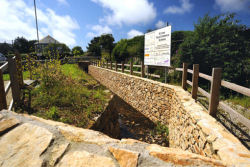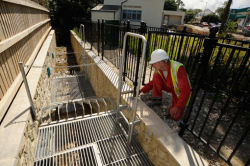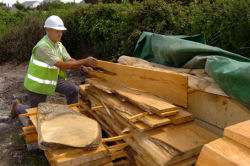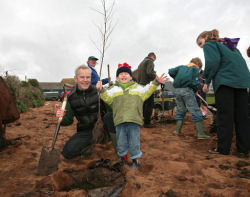St Ives Flood Defence Scheme |
|
Whole Project Award
Project Team:
Client: Environment
Agency
Design: Halcrow
Construction: Carillion
 |
|
The project
The popular tourist resort of St Ives in Cornwall has suffered serious flooding in the past, with 10 separate events in the last 20 years alone. A major cause of this was the fast-flowing Stennack River, which regularly over-topped its bank during heavy rain. This, combined with the steep hills and density of buildings at the lower end of the catchment, meant there was often very little time between the rainfall and the flooding occurring.
In the past, hundreds of properties were cut off during major flood events causing serious disruption. The new £10.5 million flood defence scheme protects 200 properties and ensures another 2,500 homes and businesses remain accessible. It reduces the chance of flooding to 1 in 150 in any year.
Construction of the flood defence works started in April 2006 and was completed in August 2008. The works included:
- fluvial flood defences and highway surface water drainage along a 2-km stretch of the Stennack River
- approx. 220m of new flood walls and five screen chambers
- seven new pre-cast concrete culverts across existing roads and re-lining of 914m of existing stone culvert
- construction of 6 highway drains to collect road water run-off and divert it back into the Stennack River.
Some of the challenges the construction team was facing included narrow access roads, space restrictions at the work sites, summer road embargoes and high pedestrian volumes during holiday periods.
Team approach
Early contractor involvement and an integrated team approach delivered several key successes, including:
- securing a waste compound (for the 2-year project duration) within the planning application
- a Site Waste Management Plan which, despite limited space alongside the working area, enabled the team to achieve recycling rates of over 98%. Waste was either reused on site or sent for recycling or recovery.
- improved H&S by removing materials from the narrow working spaces.
- estimating staff travel CO2 impacts and agreeing methods to reduce this through car sharing, train use and use of telecommunications.
- identifying opportunities to trial soft engineering solutions on a high energy river with team buy-in, which helped to reduce the use of engineering materials, increase habitat and gave a visually softer look to the area.
 |
|
Innovation
All EA schemes adopt a pro-active approach to environmental management and include setting challenging targets for all suppliers in terms of waste reduction, recycling, and use of FSC-certified timber.
However, the Whole Project CEEQUAL Award encouraged all team members to look for ways to go the extra mile, pushing recycling rates even higher, reducing the need for imported materials, finding uses for felled trees for the benefit of the community and other innovative approaches. These have included:
Installation of cross drains to catch rainwater as it runs down the hill and divert it into culverts. This is the first time the Agency has used this technology on a flood defence scheme in the UK.
Within the site offices, initiatives included low-water-use toilets, switch-off stickers on lights, monitors etc, fair-trade coffee/tea, recycling of waste.
St Ives is the first Environment Agency scheme to use a Carbon Calculator, which works out the carbon footprint of the whole project. The calculator, which measures energy efficiency, covers everything from staff travel to the embedded energy of materials used. The Environment Agency will now use this method on flood defence schemes across the country.
Ecology
- Planting of over 500 native trees to replace those lost during construction of the scheme. Five new trees were provided for each one felled. In places, the scheme was redesigned to allow mature trees to be retained.
- Use of fast-growing willow on a stretch of riverbank on the River Stennack, upstream of the town’s Fire Station, to create a ‘living wall’ that slows down floodwaters and helps prevent erosion, as well as providing habitat for birds and other wildlife.
- Water quality on the River Stennack and beach outfall has been improved by diverting misconnections and dirty water discharges to the sewers.
- Bird and bat boxes were incorporated into a section of flood wall.
 |
|
Community & stakeholder involvement
- The use of proactive community engagement and consultation, such as early consultation on options, led to a complete rethink of the Environment Agency’s preferred option.
- A Memorandum of Agreement was drawn up with the county, district and town councils, which kick-started open and frequent communication and assisted greatly in the successful implementation of the project.
- Timber from felled Monterrey Pines was used to make planters for St Ives “Britain in Bloom” as well as benches for the Ayr Field and Porthminster Gardens including a ‘Story-Telling’ bench designed by children from St Ives Junior School.
- Regular newsletters were sent to approx 300 people and distributed at the local library during the life of the project.
- Granite used in the scheme came from a local quarry at Castle-an-Dinas.
 |
|

